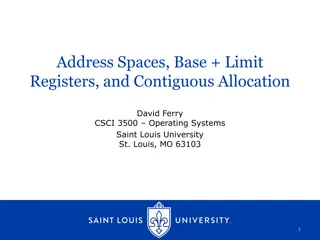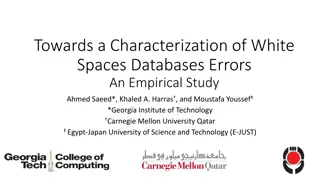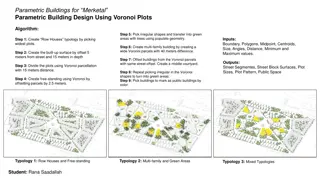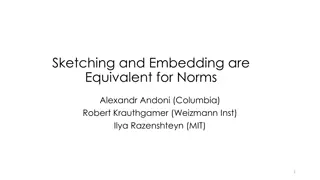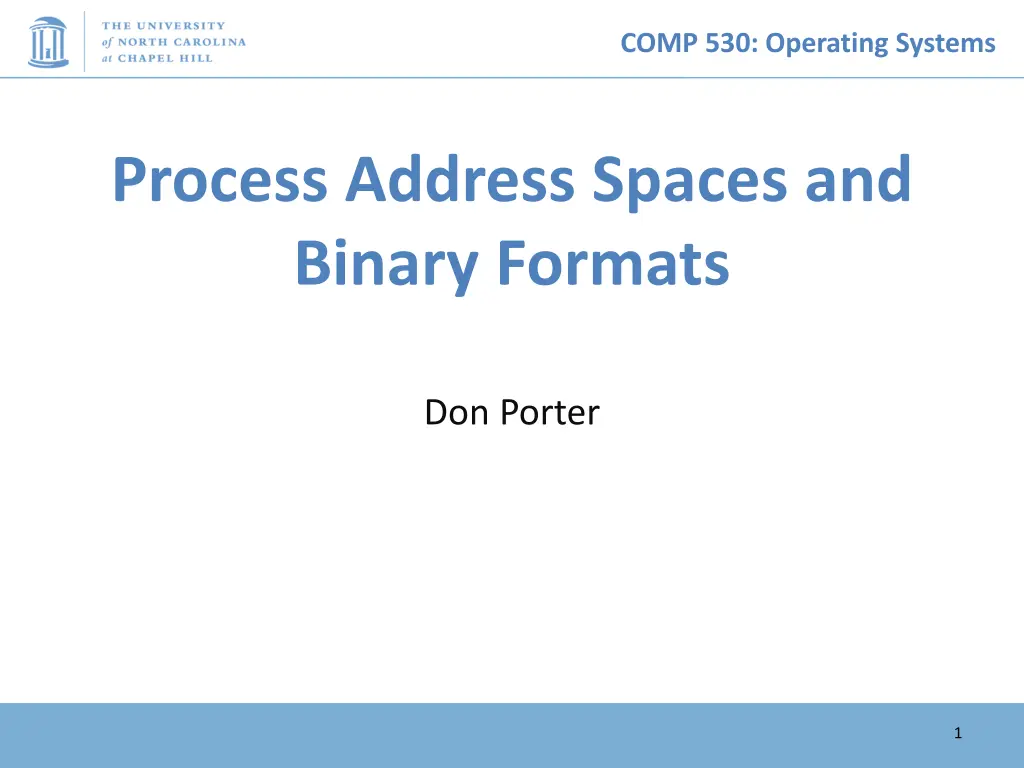
Virtual Memory Organization in Operating Systems
Explore the concepts of virtual memory, address spaces, and binary formats in operating systems through the lens of COMP.530 course with Don Porter. Learn about the layout and management of virtual memory, memory-mapped files, program binaries, and more.
Download Presentation

Please find below an Image/Link to download the presentation.
The content on the website is provided AS IS for your information and personal use only. It may not be sold, licensed, or shared on other websites without obtaining consent from the author. If you encounter any issues during the download, it is possible that the publisher has removed the file from their server.
You are allowed to download the files provided on this website for personal or commercial use, subject to the condition that they are used lawfully. All files are the property of their respective owners.
The content on the website is provided AS IS for your information and personal use only. It may not be sold, licensed, or shared on other websites without obtaining consent from the author.
E N D
Presentation Transcript
COMP 530: Operating Systems Process Address Spaces and Binary Formats Don Porter 1
COMP 530: Operating Systems Background We ve talked some about processes This lecture: discuss overall virtual memory organization Key abstraction: Address space We will learn about the mechanics of virtual memory later
COMP 530: Operating Systems Basics Process includes a virtual address space An address space is composed of: Memory-mapped files Includes program binary Anonymous pages: no file backing When the process exits, their contents go away 3
COMP 530: Operating Systems Address Space Layout Determined (mostly) by the application Determined at compile time Link directives can influence this OS usually reserves part of the address space to map itself Upper GB on x86 Linux Application can dynamically request new mappings from the OS, or delete mappings 4
COMP 530: Operating Systems Simple Example Virtual Address Space hello libc.so heap stk 0 0xffffffff Hello world binary specified load address Also specifies where it wants libc Dynamically asks kernel for anonymous pages for its heap and stack 5
COMP 530: Operating Systems In practice You can see (part of) the requested memory layout of a program using ldd: $ ldd /usr/bin/git linux-vdso.so.1 => (0x00007fff197be000) libz.so.1 => /lib/libz.so.1 (0x00007f31b9d4e000) libpthread.so.0 => /lib/libpthread.so.0 (0x00007f31b9b31000) libc.so.6 => /lib/libc.so.6 (0x00007f31b97ac000) /lib64/ld-linux-x86-64.so.2 (0x00007f31b9f86000) 6
COMP 530: Operating Systems Many address spaces What if every program wants to map libc at the same address? No problem! Every process has the abstraction of its own address space How does this work?
COMP 530: Operating Systems Memory Mapping Process 1 Process 2 Virtual Memory Virtual Memory // Program expects (*x) // to always be at // address 0x1000 int *x = 0x1000; 0x1000 Only one physical address 0x1000!! 0x1000 Physical Memory 0x1000
COMP 530: Operating Systems Two System Goals 1)Provide an abstraction of contiguous, isolated virtual memory to a program We will study the details of virtual memory later 2) Prevent illegal operations Prevent access to other application No way to address another application s memory Detect failures early (e.g., segfault on address 0)
COMP 530: Operating Systems What about the kernel? Most OSes reserve part of the address space in every process by convention Other ways to do this, nothing mandated by hardware
COMP 530: Operating Systems Example Redux Virtual Address Space Linux hello libc.so heap stk 0 0xffffffff Kernel always at the top of the address space Hello world binary specifies most of the memory map Dynamically asks kernel for anonymous pages for its heap and stack
COMP 530: Operating Systems Why a fixed mapping? Makes the kernel-internal bookkeeping simpler Example: Remember how interrupt handlers are organized in a big table? How does the table refer to these handlers? By (virtual) address Awfully nice when one table works in every process
COMP 530: Operating Systems Kernel protection? So, I protect programs from each other by running in different virtual address spaces But the kernel is in every virtual address space?
COMP 530: Operating Systems Protection rings Intel s hardware-level permission model Ring 0 (supervisor mode) can issue any instruction Ring 3 (user mode) no privileged instructions Rings 1&2 mostly unused, some subset of privilege Note: this is not the same thing as superuser or administrator in the OS Similar idea Key intuition: Memory mappings include a ring level and read only/read-write permission Ring 3 mapping user + kernel, ring 0 only kernel
COMP 530: Operating Systems Putting protection together Permissions on the memory map protect against programs: Randomly reading secret data (like cached file contents) Writing into kernel data structures The only way to access protected data is to trap into the kernel. How? Interrupt (or syscall instruction) Interrupt table entries protect against jumping into unexpected code
COMP 530: Operating Systems Outline Basics of process address spaces Kernel mapping Protection How to dynamically change your address space? Overview of loading a program
COMP 530: Operating Systems Linux APIs mmap(void *addr, size_t length, int prot, int flags, int fd, off_t offset); munmap(void *addr, size_t length); How to create an anonymous mapping? What if you don t care where a memory region goes (as long as it doesn t clobber something else)?
COMP 530: Operating Systems Example: Let s map a 1 page (4k) anonymous region for data, read-write at address 0x40000 mmap(0x40000, 4096, PROT_READ|PROT_WRITE, MAP_ANONYMOUS, -1, 0); Why wouldn t we want exec permission? 18
COMP 530: Operating Systems Idiosyncrasy 1: Stacks Grow Down In Linux/Unix, as you add frames to a stack, they actually decrease in virtual address order Example: main() Stack bottom 0x13000 0x12600 foo() 0x12300 bar() 0x11900 Exceeds stack page OS allocates a new page 2 issues: How to expand, and why down (not up?)
COMP 530: Operating Systems Problem 1: Expansion Recall: OS is free to allocate any free page in the virtual address space if user doesn t specify an address What if the OS allocates the page below the top of the stack? You can t grow the stack any further Out of memory fault with plenty of memory spare OS must reserve enough virtual address space after top of stack But how much is enough ?
COMP 530: Operating Systems Feed 2 Birds with 1 Scone Unix has been around longer than paging Data segment abstraction (we ll see more about segments later) Unix solution: Grows Grows Heap Stack Data Segment Stack and heap meet in the middle Out of memory when they meet Just have to decide how much total data space
COMP 530: Operating Systems brk() system call Brk points to the end of the heap sys_brk() changes this pointer Grows Grows Heap Stack Data Segment
COMP 530: Operating Systems Relationship to malloc() malloc, or any other memory allocator (e.g., new) Library (usually libc) inside application Takes in gets large chunks of anonymous memory from the OS Some use brk, Many use mmap instead (better for parallel allocation) Sub-divides into smaller pieces Many malloc calls for each mmap call Preview: Lab 2
COMP 530: Operating Systems Outline Basics of process address spaces Kernel mapping Protection How to dynamically change your address space? Overview of loading a program
COMP 530: Operating Systems Linux: ELF Executable and Linkable Format Standard on most Unix systems 2 headers: Program header: 0+ segments (memory layout) Section header: 0+ sections (linking information)
COMP 530: Operating Systems Helpful tools readelf - Linux tool that prints part of the elf headers objdump Linux tool that dumps portions of a binary Includes a disassembler; reads debugging symbols if present
COMP 530: Operating Systems Key ELF Sections .text Where read/execute code goes Can be mapped without write permission .data Programmer initialized read/write data Ex: a global int that starts at 3 goes here .bss Uninitialized data (initially zero by convention) Many other sections 27
COMP 530: Operating Systems How ELF Loading Works execve( foo , ) Kernel parses the file enough to identify whether it is a supported format Kernel loads the text, data, and bss sections ELF header also gives first instruction to execute Kernel transfers control to this application instruction
COMP 530: Operating Systems Static vs. Dynamic Linking Static Linking: Application binary is self-contained Dynamic Linking: Application needs code and/or variables from an external library How does dynamic linking work? Each binary includes a jump table for external references Jump table is filled in at run time by the linker
COMP 530: Operating Systems Jump table example Suppose I want to call foo() in another library Compiler allocates an entry in the jump table for foo Say it is index 3, and an entry is 8 bytes Compiler generates local code like this: mov rax, 24(rbx) // rbx points to the // jump table call *rax Linker initializes the jump tables at runtime
COMP 530: Operating Systems Dynamic Linking (Overview) Rather than loading the application, load the linker (ld.so), give the linker the actual program as an argument Kernel transfers control to linker (in user space) Linker: 1) Walks the program s ELF headers to identify needed libraries 2) Issue mmap() calls to map in said libraries 3) Fix the jump tables in each binary 4) Call main()
COMP 530: Operating Systems Key point Most program loading work is done by the loader in user space If you strace any substantial program, there will be beaucoup mmap calls early on Nice design point: the kernel only does very basic loading, ld.so does the rest Minimizes risk of a bug in complicated ELF parsing corrupting the kernel
COMP 530: Operating Systems Other formats? The first two bytes of a file are a magic number Kernel reads these and decides what loader to invoke #! says I m a script , followed by the loader for that script The loader itself may be an ELF binary Linux allows you to register new binary types (as long as you have a supported binary format that can load them
COMP 530: Operating Systems Recap Understand the idea of an address space Understand how a process sets up its address space, how it is dynamically changed Understand the basics of program loading




